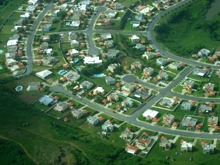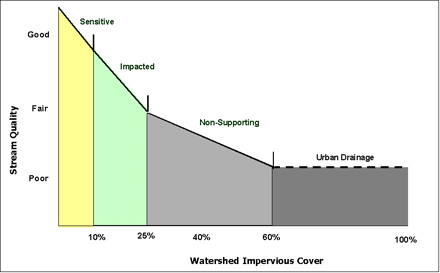Coastal Issues | Cumulative Impacts
Cumulative and Secondary Impacts of Development
Cumulative and secondary impacts of development—impacts that may be insignificant by themselves but, when combined with all other development impacts in an area over time, become a significant problem—threaten coastal resources throughout the country. These impacts can include habitat loss, air and water pollution, hampered navigation, and loss of public access to coastal areas. Almost any type of activity within the coastal zone can cause cumulative and secondary impacts, including: residential and industrial development, such as homes and roadways; ports; energy facilities; shoreline stabilization structures; docks; boating activities; aquaculture; agricultural operations; and numerous other activities.

The cumulative and secondary impacts from development in the coastal zone can threaten coastal resources.
Although coastal counties only account for 17 percent of the country's land area, they are home to more than half of the nation's population. A 2003 Pew Oceans Commission report estimates that over the next 15 years, the coastal zone will gain an additional 27 million people—equaling more then half of the nation's total population increase.
Population growth drives development and subsequently cumulative and secondary impacts within the coastal zone. However, the real problem isn't so much that the coastal zone is developing, but how that development is occurring. The form and pattern of new development is frequently dispersed over large land areas, creating disjointed neighborhood, work and commercial centers. As a result, some large coastal metropolitan areas are consuming land 10 times faster then they are adding new residents. Impervious surfaces (e.g., roadways, rooftops, and parking lots) are also increasing dramatically. For example, the U.S. Geological Survey estimates that in the Chesapeake Bay watershed from 1990–2000, population increased by 8 percent, while impervious surfaces expanded by 41 percent. Numerous research studies confirm that as impervious surfaces cover more than 10-30 percent of a watershed, water quality and the overall health of the streams, rivers and estuaries within the watershed decline significantly.

Many studies have shown that the quality of streams, rivers and estuaries declines as impervious surface cover increases. Source: Center for Watershed Protection.
Coastal managers must grapple with reducing cumulative and secondary impacts of development. Coastal managers are working with partner agencies and communities to ensure coastal development is designed, sited and constructed in ways that preserve and protect critical coastal resources and balance coastal land uses. Comprehensive land use planning (e.g., special area management plans), low-impact development, and smart growth practices can be valuable tools for addressing cumulative and secondary impacts by helping to reduce impervious surfaces, preserve open space and foster more livable coastal communities.
In Depth: Learning more about low—impact development and smart growth practices.
Links
EPA Smart Growth Program — The Environmental Protection Agency is a national leader in promoting smart growth as a means to achieve multiple economic, community, and environmental goals. Visit the EPA Smart Growth Program website for publications, case studies, and current assistance opportunities.
National NEMO Network — The Network of Nonpoint Education for Municipal Officials (NEMO) provides information, education, and assistance to local decision-makers on how they can accommodate growth while protecting their natural resources and community character. NEMO programs play a key role in linking land use and water quality through better planning at the local level.
Low-Impact Development Center — The Low Impact Development Center is a non-profit organization dedicated to the advancement of Low Impact Development technology. Low Impact Development is a comprehensive land planning and engineering design approach with a goal of maintaining and enhancing the pre-development hydrologic regime of urban and developing watersheds.
Northeast Regional Coastal Zone Management Partners Meeting (October 2005) — The fall 2005 meeting of Northeast and Mid-Atlantic coastal programs focused on how the Coastal Zone Management Act and related efforts are being use to influence growth management in the coastal zone. Learn about the successes and barriers of implementing smarter coastal growth through a series of slideshows and case studies.
NOAA Coastal Services Center "Alternatives for Coastal Development" — This Web site illustrates three different development scenarios created for a residential area in coastal Georgia. The alternatives use economic, environmental, and social indicators to compare each scenario. This information will be useful to anyone (developers, citizens, local governments, etc.) interested in applying similar development design components in their communities.
For additional information, contact John Kuriawa.
